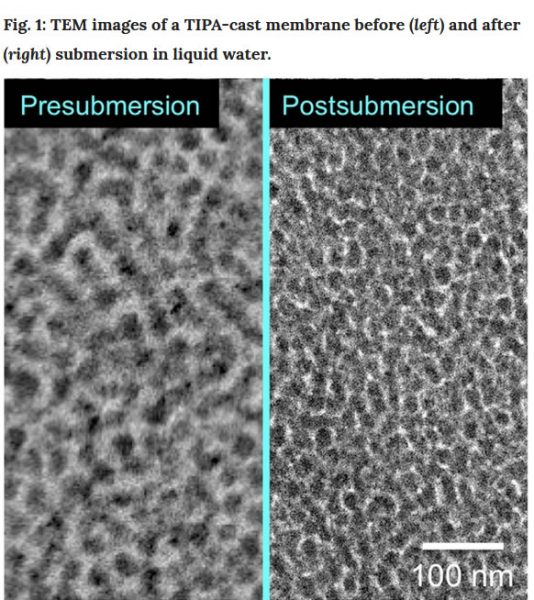Just Add Water: A Simple Step Boosts Polymer’s Ability to Filter CO2 From Mixed Gases
This article is a modified version of an article written by Matt Shipman, Research Lead in University Communications.
Professor Richard Spontak and several graduate students in his research group are members of an international research team that discovered how to significantly boost an existing polymer’s ability to selectively remove carbon dioxide (CO2) out of gas mixtures by first submerging the material in liquid water.
“Normally, improving the permeability of a gas through a material impairs the material’s selectivity,” says Prof. Spontak, co-corresponding author of a paper on the work. “To explain this using CO2 as an example, the more easily gases can pass through a material, the less able the material usually is to remove CO2 from a gas mixture. It lets through the CO2, but it lets through other gases as well. There’s a real tradeoff when engineering polymers for use as gas-separation membranes.”

“What’s remarkable about our finding is that we were able to drastically improve the polymer’s CO2 permeability while also slightly improving its CO2 selectivity. And the process that led to this substantial improvement was related to transforming the microstructure of the membrane in low-cost and nontoxic fashion – we submerged the material in water.”
Polymer membranes that can separate out CO2 from other gases are desirable for use in a variety of applications, such as removing CO2 from natural gas and sequestering CO2 in order to limit emissions from industrial facilities.
The polymer at issue here is a thermoplastic elastomer that is recyclable, relatively tough, and has been shown to have desirable properties for a wide range of contemporary technologies. For this work, the researchers set out to see how the morphology of the material – how the molecular sequences comprising the polymer molecules are arranged relative to each other – affects its performance as a CO2-selective membrane.
The permeability of gases through polymers is frequently measured in Barrer units. When dry, the permeability of CO2 through the polymer examined in the paper is less than 30 Barrer. Previous work reported by members of the team had shown that inclusion of water vapor in the feed could improve CO2 permeability, boosting it to as high as 100-190 Barrer at relative humidity levels above 85%.
“With these new results, we’ve shown we can reach a permeability of almost 500 Barrer at 90% humidity,” says Liyuan Deng, Professor of Chemical Engineering at the Norwegian University of Science and Technology and co-corresponding author of the paper. “At the same time, the selectivity of CO2 relative to nitrogen (N2) increases to as high as ~60. For comparison, the best commercial polymer membranes that could be used for CO2 capture possess a permeability up to ~200 Barrer and a CO2/N2 selectivity up to ~50. It’s very important that both of these performance metrics are considered simultaneously to achieve competitive membranes.
“This work demonstrates the polymer’s potential for use in industrial gas separation and carbon capture technologies, with benefits for both manufacturing efficiency and efforts to mitigate global climate change. It also provides a previously unexplored and facile route by which to transform the morphology of a polymer membrane and achieve tremendous improvement in gas transport properties.”
The paper, “Highly CO2-permeable membranes derived from a midblock-sulfonated multiblock polymer after submersion in water,” is published in the journal NPG Asia Materials. First author of the paper is Zhongde Dai of the Norwegian University of Science and Technology (NTNU). The paper was co-authored by Jing Deng, Hesham Aboukeila and Luca Ansaloni of NTNU; Marco Giacinti Baschetti of Università di Bologna; Jiaqi Yan, a Ph.D. student at NC State; and Kenneth Mineart, a former student in Prof. Spontak’s lab who is now a member of the Chemical Engineering faculty at Bucknell University.
The work was also reported in an article, “Simple method improves membrane CO2 separation performance,” in The Chemical Engineer. The Chemical Engineer is a publication of the Institution of Chemical Engineers (IChemE).
The research was funded with support from the European Commission within the NanoMEMC2 project in the Horizon 2020 research and innovation program and The Nonwovens Institute at NC State. The research also used resources at the Advanced Photon Source, a U.S. Department of Energy Office of Science User Facility operated by Argonne National Laboratory.